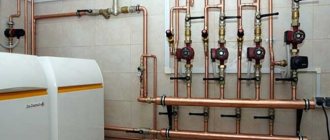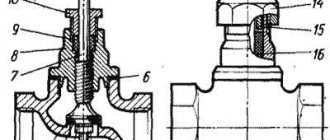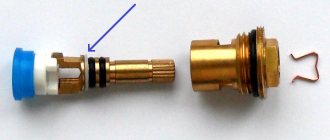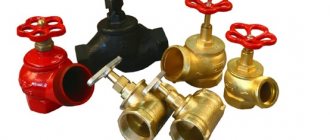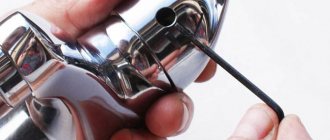Is it possible to leave the heating system without water in the summer?
Do not completely block the flow of water to the radiator.
Turning off the radiator is possible only during the period of pressure testing (a set of works to identify faults) of the heating system. Do not leave a heating system with aluminum radiators without water for more than 15 days a year.
In what position should the supply valves be located?
With regard to supply taps, it would be correct to do this: close the bottom tap, open the top tap. With this position of the taps, the presence of water in the battery throughout the entire period: spring - summer - autumn - winter will be ensured, there will be no threat of vacuum formation and everything will be fine with the battery.
What will happen if you don’t turn off the taps?
When the hot water supply starts and stops, all the rust flows through the pipes. If the taps are not turned off, very dirty water will pass through the battery and the battery may become clogged. However, if for some reason both supply taps must remain in the “closed” position, be sure to open (unscrew) the Mayevsky tap. Otherwise, the radiator may rupture due to a chemical reaction between the additives contained in the coolant and aluminum. Please note that if the radiator ruptures, this will not be a warranty case!
What if you turn off both taps?
As the water begins to cool, its volume in the battery will begin to decrease. This will cause a vacuum to form there. Why is he so scary? Your battery will experience severe pressure once a vacuum begins to form inside it. It will either become deformed or crack. To avoid this, after the end of the heating season, you should never turn off both taps!
What to do when a new heating season approaches?
After you have learned that the heating will be turned on the next day, remember that at the moment the water is supplied, the rustiest water will flow through the pipes. To avoid clogging the battery, turn off both taps! The jumper (bypass) must be open at this time!
When hot water is supplied, it will flow through the bypass. We advise you not to turn on the battery for the first couple of days. Let all the rust pass by your radiators!
From the bypass, the water in the battery will begin to heat up slightly, which will lead to an increase in pressure inside the battery, but this should not scare you. A slight increase in pressure cannot lead to deformation of the radiator.
1-2 days after supplying hot water through the jumper, open both taps on the battery.
That's it, you and your heating system are ready for winter!
For reliable and proper functioning of heating radiators, it is recommended to install special shut-off valves, which allow you to regulate the pressure and flow of the coolant, increasing or decreasing its volume. Heating efficiency very much depends on the correct choice of this technical equipment.
Currently, special ball valves for radiators are used to solve such problems. The tap is an indispensable part of any heating system, because they can, for example, completely turn off the heating in the summer or turn off the water to flush pipes and networks and regulate the temperature.
Cranes are installed to save energy and save money. Also, with the help of such simple devices you can get rid of air that may be present inside the pipes.
Types of taps for heating equipment
Today, there are several types of taps designed for heating radiators:
- The advantages of the control valve are that without shutting off the water supply system, it allows you to carry out various work with a specific battery; full-bore straight and angular balls made of brass;
- full bore balls made of polypropylene;
- control valves;
- thermostatic valves with manual and automatic control with thermal head.
The most popular and common type of shut-off device is a ball valve made of brass or polypropylene. Such taps consist of a steel ball with a selection of the required diameter for passing water, attached to a stem.
By rotating the ball, the coolant is shut off into the battery. When the tap is opened, the sample in the ball merges with the internal passage of the battery, and when closed, it shifts 90 degrees and blocks it.
The second most common is a standard manual valve , which is a design where the coolant changes flow direction twice when passing through the working section of the seat.
To reduce the amount of liquid, this section is blocked by a cone or washer with a rubber gasket attached to the rod.
How to adjust the thermal head
This type of fitting can be called the most popular invention for heating systems. The thermal head (thermal valve) is intended to regulate the heating temperature. It allows you to rationally use heat and, accordingly, increase payment savings. The classic version of the device includes the following elements:
- frame;
- bellows;
- locking element;
- shut-off rod (cone);
- return spring;
- sealing rings with fasteners;
The thermal valve itself is a valve device, which, in fact, regulates the flow of coolant into the radiator. There are three types of shut-off and adjustable valves of this type: Manual, mechanical, electronic options.
The manual version has an adjustment knob on the body to set the temperature with a scale. Comfort mode is selected by turning the knob to the right or left. Frequent adjustment is not recommended. Otherwise, rapid wear of parts will occur followed by breakdown.
Typically this element is used on cast iron batteries.
This type of shut-off valve can be called a substitute for a ball valve. Like a faucet, a thermal valve performs the functions of closing or opening the coolant supply to the battery. The difference lies in the ability to set the specified temperature. Which will be maintained at a stable pressure in the pipeline network. The advantage of this thermal valve is its relatively low cost and simplicity of design. The disadvantage should be noted that it is short-lived with frequent adjustments.
The mechanical designs of thermal heads have an advanced system and can regulate heat automatically. For example, if, in the case of manual adjustment, the temperature in the system increases, then it also increases in the room. The mechanical type of thermal valve, when the set mode is increased, locks the flow of hot water into the battery, thereby maintaining the set temperature mode. Adjustment occurs by turning the lower part of the housing according to the indicated marks.
The electronic thermal head also operates in automatic mode. It has external differences in the form of an electronic display and push-button control. It is recommended to install on foreign-made radiators. Experienced plumbers advise installing the thermostat housing horizontally outwards. To ensure proper compliance with operating conditions.
Electronic thermal head
In frequent cases, in order to avoid damage when cleaning or walking near batteries, the device is installed with the head up, or even in the battery niche. This cannot be done. Correct operation does not occur, and accordingly, the set temperature parameters are adjusted. You should also not install the thermostat near window sills. A draft from a window will lead to incorrect operation modes.
Important information. In single-pipe heating systems, when using a thermal head, it is necessary to install a bypass. Strictly speaking, this is a piece of pipe 1 size smaller than the supply. It is installed in the idea of a jumper between the supply and return.
Which taps are best to install?
If you do not need special temperature control, then it will be enough to install a regular control valve or ball valve. Such devices are very easy to install and simple to operate. Such taps are installed very often in apartments and houses.
Moreover, ball valves have only two positions, that is, either there is heating or there is not, control valves are able to regulate the flow and thereby reduce or increase the temperature in the house, but with such adjustment it is impossible to measure the exact flow and temperature.
If, on the contrary, complete and, most importantly, precise regulation of the air temperature in the room is required, then it is necessary to install thermostatic valves that can provide this.
Typically, such valves either have graduations corresponding to a certain temperature, and very advanced models have a small display showing the exact temperature, pressure and flow. Such devices are usually more expensive than previous ones, but provide greater comfort and convenience.
Radiator taps
Methods for sealing connections
If the thread profile does not have a sharp edge, FUM tape can be used as a sealant. However, this modern material has not caught on among experienced specialists; they consider flax to be the most reliable sealant. A thin strand of this material, collected into a bundle, is wound around the pipe, starting from its end. The winding direction should be opposite to the thread direction. The flax should fill the thread to its full depth, and each new turn should partially overlap the previous one. The seal will be more reliable if the thread is equipped with a notch that prevents the flax winding from turning. Before installation, the threads of the part should be coated with UniPak packaging paste or similar.
Installation on polypropylene pipes using adapter couplings.
If the heating system is made of polypropylene pipes, then metal ball valves on the heating radiators are installed using adapter couplings. All threaded connections in this case are sealed according to the method described above.
Mayevsky taps are often equipped with a gasket made of rubber or other material, so they do not need to seal the FUM with tape or tow.
When the installation or replacement of all shut-off and control valves has been completed, it is necessary to perform a test run of the system. This will make it possible to check the tightness of all connections and the functioning of the valves under operating conditions. In this case, it is important to make sure that the system is completely de-aerated and the working medium circulates normally in it. A small amount of sealing material should be added to threaded connections that are found to be leaking.
Why can batteries heat poorly? The main reason for insufficient heating of radiators is the appearance of air in them. It was for this purpose, more than eighty years ago, that a special device was invented for removing air from radiators and heating pipes - the Mayevsky tap (or Mayevsky valve).
Installation
Since a ball valve is the most popular type of shutoff of liquid entering the battery, we will consider detailed instructions for installing such a device.
Before starting work, it is necessary to completely remove the coolant from the heating system, that is, completely shut off the water supply. The ball valve must be installed in the area between the radiator and the bypass - a device that ensures proper water circulation in the system.
Before installation, you need to wrap the tap threads with a special sealant for better sealing. There are a few things to consider when installing a faucet. Firstly, nothing should interfere with turning the faucet handle, no obstacles in the form of pipes or other elements, but if something interferes, then it is necessary to reduce the handle. Also, the user of the heating system must have a convenient approach to the faucet handle.
After this, you can safely install the tap, but you also need to take into account the thread. After installation, it is necessary to check the connections for leaks and various leaks, in order to avoid them you should not spare the sealant - a special sealing tape that can be purchased at any hardware store.
After this, you can install the battery. It is necessary to check all connections for leaks by turning on the water supply, preferably at high pressure.
Thus, installing a tap on heating radiators requires only a few simple rules, following which you can install any device for shutting off and adjusting the coolant.
After installation, it is necessary to check the connections for leaks and various leaks, in order to avoid them, you must not spare the seal
How to open a ball valve
A ball valve refers to elements of shut-off valves that prevent adjustment of liquid pressure at any pressure. Its main task is to completely block the flow of liquid or vice versa. If the ball is not closed or opened sufficiently (until the lever stops), wear occurs on the ball, which quickly leads to its breakage.
How to correctly determine the operating condition of a ball valve. The design itself provides for the use of an L-shaped lever, about 10 cm long, as a handle. This is done so that the user does not apply much effort when turning the lever. Attention, when the lever is installed along the water pipe, the tap is open (water flows into the radiator). If the lever is perpendicular to the pipe, this is a closed position (no fluid flows into the battery).
Ball valves are often used in "passive" applications. Usually this is a drain, on batteries, to release air. Or central coolant supply in individual heating systems.
What to consider when installing taps
When installing various taps, it is necessary to take into account, firstly, personal preferences, that is, whether you want to overpay for more precise temperature control, and secondly, the parameters of the room, house, and so on.
The instructions for installing shut-off valves of various types are very similar to each other. It is imperative to check everything for leaks in order to avoid accidents; you also need to take into account the convenience of using such devices. You shouldn’t waste money on a seal; it’s better to choose trusted manufacturers.
If you do not understand anything about installing shut-off valves, then it is better to consult with a professional about what type of faucet you should install in your home.
The word “faucet” is used when talking about different types of shut-off valves. They also use taps for radiators installed both in apartments and taps for heating radiators in private households.
Methods for sealing connections
If the thread profile does not have a sharp edge, FUM tape can be used as a sealant. However, this modern material has not caught on among experienced specialists; they consider flax to be the most reliable sealant. A thin strand of this material, collected into a bundle, is wound around the pipe, starting from its end. The winding direction should be opposite to the thread direction. The flax should fill the thread to its full depth, and each new turn should partially overlap the previous one. The seal will be more reliable if the thread is equipped with a notch that prevents the flax winding from turning. Before installation, the threads of the part should be coated with UniPak packaging paste or similar.
Installation on polypropylene pipes using adapter couplings.
If the heating system is made of polypropylene pipes, then metal ball valves on the heating radiators are installed using adapter couplings. All threaded connections in this case are sealed according to the method described above.
Mayevsky taps are often equipped with a gasket made of rubber or other material, so they do not need to seal the FUM with tape or tow.
When the installation or replacement of all shut-off and control valves has been completed, it is necessary to perform a test run of the system. This will make it possible to check the tightness of all connections and the functioning of the valves under operating conditions. In this case, it is important to make sure that the system is completely de-aerated and the working medium circulates normally in it. A small amount of sealing material should be added to threaded connections that are found to be leaking.
Shut-off and control valves, which are often called taps in everyday life, are the most important part of any heating system. Errors when choosing or installing these devices very often are not limited to a deterioration in the performance of the heating system, but lead to emergency situations with very tangible consequences. Hot water gushing out with strong pressure from a burst or broken faucet will have time to cause considerable damage while the system is completely turned off, and in the worst case, it can result in burns and other injuries. Therefore, the selection, installation and operation of fittings should be approached very carefully. We'll talk about how to do all this correctly.
Why install taps for heating radiators
Shut-off valves perform the following functions:
- it is used when a separate section of the heat supply structure or heating device is completely disconnected. The need for this arises when carrying out repair work or changing the configuration of the heating system;
- the taps are used to adjust the permeability of the coolant in semi-automatic or manual mode and thereby change the air temperature in the room;
- it is used to release air or coolant. In the first case, air pockets are removed from the heating system. Since the pressure drop in the structure is insignificant, if it occurs in the riser or in a separate section of the air circuit, water will not be able to circulate through the pipelines and batteries. In another case, the coolant is discharged to flush radiators or perform repair work.
About the problems of air accumulation in the heating system
In closed heating systems, air accumulates in the radiators for several reasons. When the coolant heats up, bubbles form in it. When filling the system, air may enter along with water. For this reason, it is recommended to do it slowly, especially in complex systems with many turns. Pipe airing also occurs after local pipeline repairs.
What does this lead to?
- Firstly , the heat distribution process may be disrupted. Due to the air lock, the radiator will be slightly warm on top and very cold on the bottom.
- Secondly , extraneous sounds may be heard from the system: hissing, gurgling, etc.
- Thirdly , air accumulation can cause corrosion, especially in aluminum and bimetallic radiators.
A Mayevsky tap will help get rid of air in the heating system. To bleed the air, you don’t have to call a plumber. You can handle it yourself. The main thing is to know how to do it correctly.
Elevator unit
In apartment buildings, valves are usually installed at the entrance and exit of the elevator unit of the heating system. Their body has two rings made of corrosion-resistant steel, which encircle the passage for the coolant (mirrors). Another pair of mirrors is located on the surface of the valve - its moving part.
When the damper is in the lower position and lowers, it blocks the movement of water, but if it moves to the upper position, it goes beyond the circulating flow.
If this parameter is lower, it is recommended to use modern plug valves, such as in the photo, since valves have serious disadvantages:
- it is necessary to periodically fill the oil seal, even when the valve is not in use, since the packing, in contact with water, is gradually destroyed;
- After a short period of time, the cheeks begin to become overgrown with deposits. If the valve sits for several years without being used, it will not be possible to close it completely;
- In the event of an emergency, every second can be decisive. If it takes literally a moment to close the plug valve, then it will take a long time to rotate the valve’s steering wheel, even when it is fully operational.
It should be noted that plug valves, which are a ball with a channel for water surrounded by a plastic shell, differ in:
- practicality;
- durability;
- reliable fluid retention;
- no need for maintenance.
Plumbing specialists do not recommend purchasing and installing a screw valve on a heating radiator or the same products of any other type.
They have significant design disadvantages:
- The seal will need to be filled periodically if there is no desire to put up with constant leakage along the rod. When it is difficult to replace the valve or fill the oil seal, then to eliminate the leak, the valve must be opened all the way with a little force. The leak will stop due to the fact that the thread on the rod will press the oil seal:
- Rubber gaskets for elements of heating structures have a limited shelf life. Heating radiator valves with flat brass valves do not hold water after a certain time due to the appearance of deposits on the valve and seat. These same locking elements with wedge-shaped valves made of brass, after closing them with force, often jam in the seat (about
How to turn off the heating radiator in an apartment where it is hot in winter
In this material, we want to explain to residents of apartment buildings how to shut off a heating radiator connected to a centralized heating network. Such a need may arise for various reasons at any time of the year. In a private house this is not a problem, but in an apartment where the radiators are connected to a common network with neighboring heating devices, shutting off the radiators can lead to negative consequences.
When to turn off radiators
There are several situations when you need to turn off the water in the battery:
- in the event of an emergency that threatens to flood your own and neighbors’ homes with hot coolant;
- if you decide to paint the radiator during the heating season;
- when you need to change or wash the battery without blocking the riser;
- you need to limit the flow of heat into a room that is hot in winter.
Radiators that are too hot are the cause of heat and stuffiness in the apartment
Note. Some apartment owners practice shutting off heating radiators for the summer while preserving the coolant. The goal is to protect heating devices from clogging during the autumn start-up of the system, when a lot of rust flows through the pipes. Below we will explain how to do this correctly.
Now the main point: you will never have problems with how to disconnect a radiator from a centralized system if it is connected according to the correct circuit using shut-off valves (ball valves). You will be able to shut off the coolant flow at any time if such a need arises, without disturbing the thermal conditions of adjacent apartments. The shutdown algorithm is simple:
- Close the lower and then the upper valve on the battery.
- If you plan to paint the heating device, then the previous step is sufficient. Wait until the radiator is cold and paint.
- When it is necessary to replace batteries in the middle of winter, before removing each heater, release the pressure through the Mayevsky valve. Then unscrew the bottom plug and carefully drain the water, then unscrew the joints and dismantle the device.
Correct connection of the heating device to the central heating risers
A separate question is how to properly turn on the heating radiator so that there is no air pocket left in it, which prevents maximum heating of the surface and air in the apartment. Here the algorithm is similar: you need to open the lower valve, then the upper one, and at the end release the remaining air using the Mayevsky tap.
The handle stands along the axis of the pipe - the valve is open, across it - closed
Note. If you do the opposite and open the top valve first, you risk leaving some air inside the sections of the device. This is not critical, but the de-airing procedure will have to be repeated several times.
Location of the Mayevsky tap on the heating device
What to do with a stuck ball valve
If ball valves are not rotated for years, they tend to sour and jam. In such a situation, do not try to resolve the issue physically and do not force the “butterfly” with pliers or a gas wrench. It is made of a brittle alloy and will probably break. Proceed like this:
- Unscrew the locking nut and remove the butterfly handle from the stem.
- On most of these valves, you will find a nut under the handle that clamps the plastic seal. Loosen it by turning the wrench half a turn. If there is no nut, go to the next step.
- Take an adjustable wrench or other device that allows you to securely grab the flats on the rod. Without applying much force, turn it as far as possible.
- When you feel resistance, turn the rod back all the way and forward again, trying to turn it a few more degrees. Work carefully and without haste!
- In this way, rotate the valve 90°, then tighten the gland nut and reinstall the handle.
An adjustable wrench can be used to firmly grasp the edges
Advice. If you have WD-40 spray lubricant in your household, apply it to the stem and wait 5-10 minutes before rotating.
Be doubly careful when turning off radiators with soured taps during the heating season. If you hurry too much and apply too much force, you will break off the metal rod or ball, and in the worst case, the valve body will burst. A stream of hot water can shoot out from the crack, which can burn you. While you go down to the basement and close the heating riser, the coolant will cause damage to the interior of the room, and you can roughly guess how much it costs to renovate the apartment now.
If you are not sure of your actions, call a plumber. More information on how to close a jammed ball valve in order to disconnect the radiators is described in the video:
Disabling radiators without fittings
It is no secret that in most apartments to this day there are old cast iron radiators or steel convectors without any shut-off fittings, which makes it impossible to shut them off during the heating season. Moreover, according to the old heating scheme, convectors in high-rise buildings are connected to risers without straight sections - bypasses. Therefore, if an accident occurs with a coolant leak, you must act as follows:
- Try to provide some kind of container to collect hot water. If the stream flows to the side, wrap a thick cloth over the break site so that the water flows along it into a bucket.
- Call the dispatch service of your heating energy supply company and report the accident.
- While the service personnel are getting there, provide them with access to the basement, find the keys, open the door, and so on.
- Try to block the riser yourself.
Risers and valve that cuts off heating areas
The recommendations of specialists in this case do not differ in the originality of the solution, since plug valves are considered the best choice. It is necessary to create conditions in the risers for discharging the coolant liquid and plugs are chosen for this purpose, but they are not always convenient, since it will be quite problematic to unscrew the plug on the supply riser, through which a water flow with a water temperature of about 90 degrees circulates.
As a result, the conclusion is obvious: valves should be installed to discharge the water.
In this situation, you can use screw devices, since they will not have significant disadvantages:
- if the oil seal is installed correctly, it will not have contact with the water flow under pressure;
- water hammers become impossible, since the valve is mostly closed;
- To replace the gaskets, you do not need to reset the entire house system - it will be enough to stop the riser.
Types of valves
To determine the position of the device and find out how the valve opens or closes, you first need to know the type of device installed.
In household systems the following are most often installed:
- ball valves. There is a metal ball in the body of the device, which serves as a locking mechanism. The body and locking element are usually made of durable metals (brass, steel, bronze), which ensures a long period of use of the device;
Valve with ball-shaped locking mechanism
- plug valves. The locking elements in this type of device are cylindrical or conical plugs. The plug valve body is also made of high-strength metal. The locking mechanism allows the valve to be used in pipelines with aggressive media.
Valve with a cylindrical plug
In most cases, ball valves are installed on heating and water supply systems, and plug valves on a gas pipeline.
Installation of air vents
A typical tap for a radiator is a product by Mayevsky. The faucet is a simple structure made of a brass rod, which in the closed position covers the hole in the seat, and threads to install it in the radiator plug (for more details: “What is the Mayevsky valve needed for - features of use, characteristics”).
Such taps for heating radiators are reliable and rarely require repair or replacement, but:
- their cross-country ability is low. If you put the faucet on the riser and wait about 10 minutes once a year until the air comes out easily, then it is hardly worth installing such an air vent on the expansion tank of an apartment building with top filling. It is better to give preference to a conventional valve;
- when buying a Mayevsky faucet, you need to choose a product for a screwdriver, and not for a special key, which cannot always be quickly found before starting the heating;
- Some products of this type allow you to unscrew the rod completely; unfortunately, such cases are not uncommon. No one has yet succeeded in screwing the rod into place, overcoming the resistance of the hot coolant.
An alternative to the Mayevsky tap is a drilled radiator plug or an adapter with a screwed-in plug valve. Sometimes, for this purpose, a regular water tap is used, which is placed in an inverted position - with the spout up.
When installing a tap on a heating radiator in this way, you need to remove the handle and knob from the valve, since a small child in the house will be attracted to a bright object, and he will eventually try to turn it. The consequences will be unpleasant.
Is it worth turning off heating appliances?
Attention! Ball valves cannot be used to regulate the flow of coolant if you want to reduce the heating of the batteries! This valve is a shut-off valve; its use for other purposes leads to destruction of the valve and leaks.
Based on the above, if there is no bypass, but ball valves are installed, the battery can be dismantled independently for repair or replacement, but not during the heating season.
Heater with installed bypass
The bypass (jumper) is mounted parallel to the radiator and is usually a pipe whose diameter is equal to the diameter of the supply pipes or one step smaller. If you plan to shut off the radiators after the heating season or install a radiator with a thermostat, be sure to take care of installing a bypass. Otherwise, your actions will lower the temperature of the coolant and your neighbors.
Taps that regulate battery temperature
Control valves for heating radiators are of the following types:
- standard;
- with thermal head.
The most successful way to solve the problem with coolant temperature is to install a thermostatic head. After it is adjusted with a trim throttle, it will serve throughout the heating season.
The control valve on the heating radiator will maintain a comfortable temperature in the room. The thermostat is mounted on the supply line of the supply pipe in such a way that the temperature-sensitive element is not subject to heating due to the ascending flow of hot air masses.
A throttle is considered a cheaper option, but it needs to be adjusted manually depending on the required degree of heating of the rooms in the house, which is of course not very convenient. After all, both the radiator and the rooms have great inertia: the air temperature can stabilize only after several hours after the throttle opening is changed.
Also, to regulate the movement of coolant through the supply pipe, a conventional plug valve is used. In principle, it is not intended for this, but with its help, configuration is possible.
Adjusting batteries using a thermostat
To ensure constant maintenance of the desired temperature in the room, thermostats for radiators are used. These devices have other names - thermostatic valve, thermostatic valve, etc. There are many names, but they all refer to one product.
The thermal valve and thermal valve are the lower part of the device, and the thermal head and thermoelement are the upper part. Most of these products operate without power sources. The exception is models equipped with a digital screen, in which batteries are placed in the thermostatic head. There is no need to change them often, since the current consumption is negligible.
The radiator thermostat consists of several components:
- thermostatic valve, which is called “housing”, “thermal valve”, “thermal valve”;
- thermostatic head or “thermostatic element”, “thermoelement”, “thermal head”.
The body (valve) is made of metal, usually bronze or brass. Externally, its design resembles a manual valve. Many manufacturers make the lower part of the radiator thermostat unified. This means that different types of heads can be mounted on one housing, regardless of their manufacturer.
Thus, it is possible to install a thermoelement with different controls on the thermal valve - manual, mechanical or automatic, which is very convenient. If you want to change the adjustment method, there is no need to buy the entire device, you just need to install a different thermostatic element.
Automatic regulators differ in the principle of influencing the locking mechanism. In a manual device, its position is changed by turning the handle. As for automatic models, they usually have a siphon that puts pressure on a spring-loaded mechanism. In electronic products, the workflow is controlled by a processor.
The bellows is the main element of the thermoelement (thermal head). It looks like a small sealed cylinder containing liquid or gas inside. Both of these substances have a common property - their volume depends on temperature. When heated, gas and liquid begin to significantly increase in volume and thereby stretch the cylinder.
The bellows, when pressed on the spring, blocks the flow of coolant. When the volume of the working medium decreases as it cools, the spring rises and thereby the fluid flow increases, and the radiator heats up again. Thanks to the use of such a device, depending on its calibration, the set temperature can be maintained with great accuracy - up to one degree.
Before using a radiator, anyone who decides to purchase a thermostat for it must decide what type of temperature control it should have:
- manual;
- auto;
- with built-in or remote sensor.
Models designed for one-pipe and two-pipe systems, with housings made of different metals, are also available.
Recommendations from experts
Experts in the field of heating engineering advise:
- screw valves for adjustment are not suitable for shut-off valves, since after a short time the valve will certainly come off or be destroyed;
- it is necessary to purchase coupling ball valves for heating radiators;
- to adjust the flow of the heating battery, a fully open bypass jumper is required;
- On the second supply line, it is advisable to install another valve, which in the closed position completely cuts off the heating device, after which the radiator can be removed for repair.
Taps for heating radiators on video:
Mayevsky manual crane
Mayevsky manual crane
The Mayevsky manual type crane always has one design, regardless of the product. The main differences between different products are the diameter of the external thread on the valve body. Common tap diameters are 15 and 20 mm. There are taps with a thread diameter of 25 mm. The adjusting screw of the Mayevsky valve usually has a tetrahedral head shape (only sometimes 6- and 8-sided ones are used), with a slot for a regular screwdriver. Therefore, the tap can be adjusted either with a special key, which is supplied in the kit, or with a flat screwdriver. Models of the Mayevsky crane are also manufactured, which have a handle for adjusting the screw. When purchasing a faucet, you should pay attention to the markings. It indicates the thread diameter in mm. The thread parameters are also indicated. For example: M10x1. Length 10 mm, with thread pitch 1 mm.
